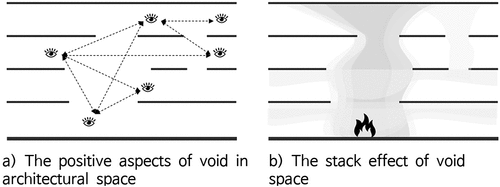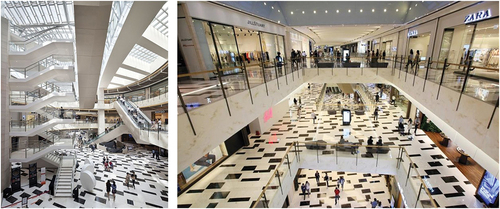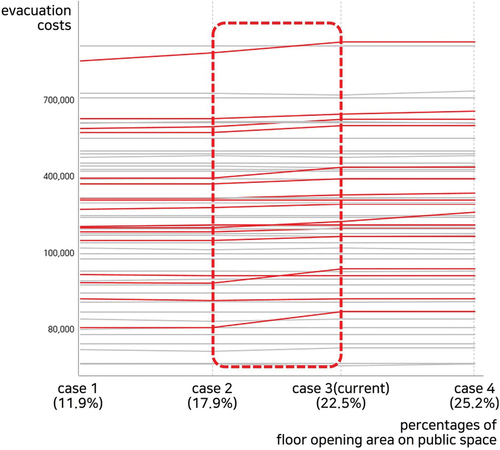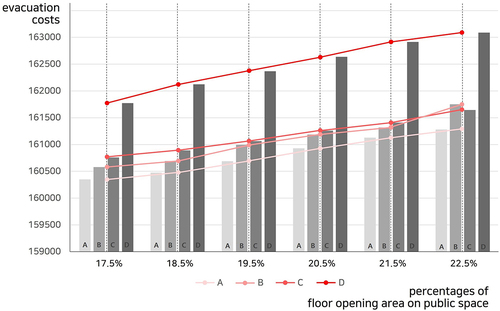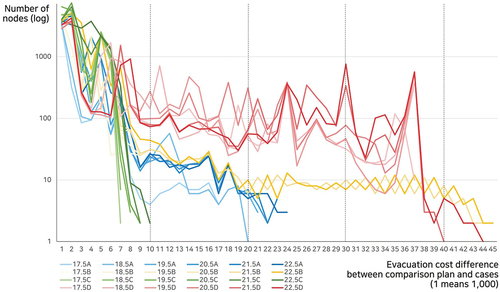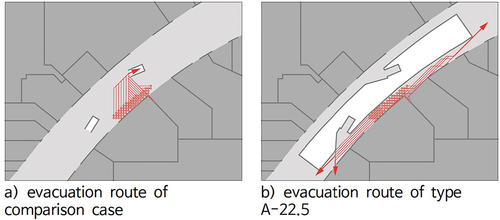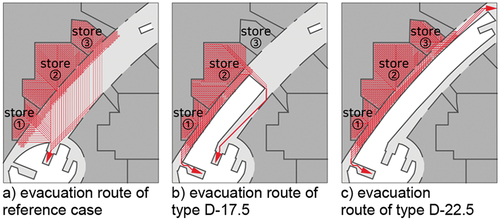 ?Mathematical formulae have been encoded as MathML and are displayed in this HTML version using MathJax in order to improve their display. Uncheck the box to turn MathJax off. This feature requires Javascript. Click on a formula to zoom.
?Mathematical formulae have been encoded as MathML and are displayed in this HTML version using MathJax in order to improve their display. Uncheck the box to turn MathJax off. This feature requires Javascript. Click on a formula to zoom.ABSTRACT
To achieve evacuation-optimized design at the architectural planning phase, this study analyzed the effect of floor openings in multipurpose commercial buildings on their evacuation efficiency. Herein, the IFC Mall in Yeouido, Seoul, Korea was considered the study site, because all the factors influencing the evacuation efficiency can be controlled owing to the underground location of all floors. Therefore, all evacuees followed the same evacuation direction. Comprehensively, a spatial analysis methodology(Cellular ECEM) was employed to derive the evacuation costs through the sum of visibility cost and distance cost. Subsequently, the evacuation costs were compared in all cases to review the hindrances in evacuation according to the type and area ratio of the planned floor opening, and several causes of evacuation cost deviations were discussed. Overall, increasing the area of the floor opening deteriorates the evacuation efficiency. The evacuation efficiency increased if the area of the floor opening is appropriately separated and a bridge is constructed in the middle to connect a path. Furthermore, following the longer path around the floor opening to use the main vertical means of circulation, owing to the connection between the atrium and floor opening, is more vulnerable toward evacuation efficiency than other floor opening types.
1. Introduction
1.1. Overview
A multipurpose commercial building is an infrastructure complex of several commercial facilities such as retails, movie theaters, book stores. To satisfy diverse consumer demands within a single building, the design of a multipurpose commercial building has become more complicated in the three-dimension scale. Specifically, the floor opening is employed as a design strategy to encourage consumption and provide a multidimensional experience of the space.
In contrast, owing to the complexity of the space caused by the floor opening, the personnel using such buildings encounter challenges in navigation. In particular, a complicated circulation system can act as an obstacle to evacuation, which delays the evacuation completion time. In such conditions, evacuees might experience difficulty in recognizing the evacuation route, and therefore, fails to immediately respond during an emergency.
The existing research literature on evacuation from a multipurpose commercial building with relation to its floor opening has primarily focused on the aspects of building facility such as ventilation system, planning of sprinklers, or fire monitoring technologies.
1.2. Objectives
This study aims to investigate the effect of the floor opening, a widely used architectural planning element in a multipurpose commercial building, on evacuation efficiency.
Additionally, this study presents an architectural planning perspective on the research trends related to disaster response and evacuation in buildings, which are currently advancing in the field of architectural research. The existing research literature on disaster response and evacuation in buildings primarily focuses on performance-based design accounting the ability of individual evacuee, evacuation-related sensor technology, and the burning duration of finished materials. Therefore, the study intends to conduct evacuation-related research in terms of architectural planning in the early stage of architectural design process to enable disaster response, management, and evacuation.
1.3. Subjects and methods
In Chapter 2, previous studies and international regulations on the floor opening are reviewed to understand the critical considerations on evacuation efficiency concerning the floor opening.
Thereafter, the research methodologies and processes are introduced in Chapter 3. The cases for analysis are differentiated based on the types and size ratios of the floor openings of IFC Mall, Yeouido, Seoul, Korea. Herein, we used Cellular ECEM software to quantitatively evaluate the evacuation efficiency of each case. The results of each case were compared to investigate the influence of the type and size ratio of the floor openings on evacuation efficiency. Summarily, the architectural planning aspects of the analysis site, setting of nodes and links in the Cellular ECEM software, and the floor opening types and size ratios are detailed in Chapter 3.
In Chapter 4, the effects of the floor openings on evacuation efficiency are discussed in terms of the optimal evacuation routes derived from Cellular ECEM. Furthermore, we examined the evacuation cost varying with the type and size ratio of the floor openings. In addition, the correlation of these factors with the evacuation efficiency was re viewed. Lastly, the nodes exhibiting meaningful alterations of the evacuation route were investigated.
2. Literature review
2.1. Regulations
The present regulations on the floor opening primarily comprise regulations on the atria. According to National Fire Protection Association (NFPA), “atria” is defined as “a large-volume space created by a floor opening or series of floor openings connecting two or more stories.” Therefore, the regulations on the atria can be reasonably applied as those on the floor openings.Footnote1
In 1985, the Great London Council (UK GLC) first established atria-related regulations and stipulated that all walls adjacent to the atria be installed as firewalls, except for the lowest two floors with less than 24.0 m of floor height. Per recommendation, at least two mechanical exhaust pipes should be installed to ventilate more than 10.0% of the atrium area in each atrium.
In the United States, the regulations of NFPA 1852(2019), NFPA 101: Life safety Code, NFPA 92B: Standard for Smoke Management System in Malls, Atria, and Large Spaces concern the atrium with regard to disaster prevention and evacuation. For disaster prevention, the use of necessary equipment is stipulated, such as fire doors, firewalls, and smoke exhaust facilities in the atrium. In the atrium, the installation of operable smoke windows and smoke facilities are required. Moreover, the amount of smoke should be determined according to the height and size of the atrium. To promote more efficient evacuation, a billboard should be installed in the atrium to visually convey the evacuation route.
The Republic of Korea specifies regulations on fire prevention and evacuation in the “Act on Fire Prevention, Installation, Maintenance and Safety Management of Firefighting Facilities.” In case of the regulations directly related to the floor opening, there are “Rules on Equipment Standards for Buildings, etc.” that recommends a ceiling height of 3.0 m or more to install smoke exhaust facilities or windows in each atrium.
In Japan, the installation of fire shutters is compulsory for all areas adjacent to the floor opening and atrium. However, the construction of these fire shutters poses practical problems such as increased construction cost, reliability in emergency performance, and design restrictions. Therefore, in case the safety level is equal to or greater than that required, a design without a fire shutter can be exceptionally approved based on “Accreditation of the Minister of Construction under Article 38 of the Building Act.” In Japan, the safety level is evaluated by fire-resistance structures, fire compartments, smoke-extinguishing facilities, and prevention plans.
The prevention measures of smoke and fire propagation in the floor opening are specified through smoke exhaust facilities, fire shutters, opening directions of exits, fire prevention zoning, and performance-based design in architecture. However, such regulations can be regarded as regulations in terms of building systems and not architectural planning. This will aid evacuation in multipurpose commercial buildings used by unspecified personnel at a more fundamental level, if the architectural plan considers disasters and evacuation situations from the early stage of the architectural design process.
2.2. Previous studies
Hung (Citation2003) categorized the atrium of a multipurpose commercial building into four distinct types. He asserted the effects of the atrium in a commercial building. The central location of the atrium in the building is advantageous for insulation and natural light, and if it is located on one side of the building, it can provide a sense of openness to the building space. Also, Moosavi et al. (Citation2014) inadequately reviewed highlighted natural ventilation design of atria. The study included atrium geometries, opening characteristics, roof properties, materials and fenestration characteristics as the parameters to improve the thermal performance of energy consumption of the building.
Meanwhile, Kusumowidagdoa, Sacharib, and Widodob (Citation2015) asserted that the floor openings and atria in a multipurpose commercial building serve as elements of architectural planning that assist in securing visual continuity in the sensory dimension as well as the continuity of vertical movement in the physical dimension, as depicted in .
In addition, Lee (Citation1994) and Hung (Citation2003) discussed the significance of floor openings with an experimental demonstration in which the smoke and embers accumulated in the floor openings because of the chimney effect, as portrayed in , and consequently, spreads to the adjacent space in the upper portion of the building, thereby causing fire to rapidly grow and expand.
A study by Rafinazari and Hadjisophocleous (Citation2020) demonstrated that the airflow varies with the arrangement of floor openings, which consequently influences the heat and smoke diffusion in a fire situation. In addition, Xu, Wang, and Song (Citation2021) demonstrated that the diffusion of heat and smoke varies with the opening and the ceiling height of the atrium.
Several prior studies have proposed plans of floor openings based on engineering calculations and simulations. Park et al. (Citation2009) reviewed the evacuation safety of a building with an atrium in a fire and evacuation simulation. The propagation of smoke through an atrium reduces the visual range and convenience of evacuation in the building with the atrium that does not include an interfloor fire protection partition. Therefore, they suggested that the building should reinforce the alarm system to reduce the fire recognition time such as real-time evacuation broadcasting and a dedicated flame detector. Xu et al. (Citation2017) analyzed the exhaust velocity and air supply amount for efficient discharge of smoke from the floor openings. In this study, the experimental process revealed that the smoke spreads rapidly in the floor openings in case of fire owing to the chimney effect, thereby emphasizing the importance of efficient exhaust smoke. Lei et al. (Citation2022) suggested the concept of available evacuation passageway. The study developed a hypothesis which the top floor of an atrium usually most seriously affected by chimney effect. As a result they place underfloor breathing zone and connecting inlets to enhance the smoke exhaust flow rate, the CO concentration temperature and visibility in available evacuation passageway.
Nevertheless, floor openings are factors that provide diverse spatial experience to the visitors in the multipurpose commercial buildings. Most previous studies focused on the architectural facility system rather than architectural plannings. Furthermore, they criticized the negative impact of floor openings in terms of evacuation efficiency. Thus, this study intends to discuss more on the architectural planning aspects of the floor opening of the multipurpose commercial building, and its effects on evacuation efficiency. presents some of the key findings of the effect of the floor openings.
Table 1. Summary of previous studies.
3. Method
3.1. Subject of experiment
This research considered “Yeouido IFC Mall” as the study site, which was completed in August 2012 with a total floor area of 76,021 m.Footnote2 Unlike other commercial complexes in Seoul, Yeouido IFC Mall houses a clear circulation system as a single building, comprising complicated circulation lines that connect department stores, supermarkets, and other facilities. A unique characteristic of this mall is that all its floors are located underground, such that evacuation occurs in a single direction, and there are openings on the main circulation. Thus, the IFC Mall in Yeouido is suitable for experimental investigation on the effect of types and areas of the openings and atria, while controlling other architectural planning factors influencing evacuation efficiency.
The main circulation of the IFC Mall in Yeouido is a triangular line connecting the three cores, and stores such as the clothing stores and food and beverage stores are arranged in its surroundings. Among the three cores, two circulating atria occupy the north and southwest cores(as shown in ), and the primary means of vertical circulation such as direct stairs and escalators connecting to the ground level are situated on them. Furthermore, certain main circulation lines on the first and second basement floors bear plans of floor openings, and most of the openings are planned as a part of the circulation. However, the openings between the southwest atrium and the southeast core are planned as non-circulating. In total, as shown in the right image of , seven bridges are constructed on the first basement floor and three on the second basement floor connecting the stores on both sides of the floor openings. Currently, no non-circulating atrium is present in Yeouido IFC Mall.
3.2. Overview of cellular ECEM analysis
(1) Cellular ECEM
In this study, the evacuation cost was derived through the Cellular ECEM and used as an evacuation efficiency evaluation index. Choi, Kim, and Choi (Citation2006) developed the Cellular ECEM based on ECEM, which considers both the distance cost based on the physical distance and visual perception cost according to the degree of directional modification during movement. In principle, this is a spatial analysis methodology that quantitatively analyzes and evaluates the shortest evacuation routes along with their evacuation costs from all the nodes to exit nodes. Similar to the existing ECEM, Cellular ECEM arranges a regular grid on the subject space and designates the grid points as nodes. However, in the existing ECEM, the direct movement to all the grid points was presumed as visible in a specific grid point. Comparatively, as shown in , the direct movement in cellular ECEM is possible only toward the adjacent grid points in eight directions (up, down, left, right, and diagonal) in a specific grid point (Kim et al. Citation2020).
(2) Grid Layout of Subject Space
For Cellular ECEM analysis, a regular grid was arranged on the space to be analyzed. In the arrangement, a higher density of the grid points enables a more detailed reflection of the evacuation situation and the abrupt deviations that may occur within the space during the disaster. In this study, the grid points were arrayed at an interval of 1 m × 1 m regarding the size of Yeouido IFC Mall, such that the exits and corridors of all rooms can be connected via nodes.
(3) Weights for Means of Vertical Circulation
The Cellular ECEM can reflect the characteristics of the vertical circulation movement by applying weights to the means of vertical circulation such as stairs, ramps, and escalators. According to Edgett and Williams (Citation1958), the walking speed differs depending on the means of vertical circulation. More specifically, the walking speeds of users on stairs and escalators vary with the riser heights.
In this study, multiple weights were applied to the escalators and stairs, considering that all floors are located underground and all evacuees use the stairs and/or escalators. The weights are determined in accordance with the studies of Nelson and Mowrer (Citation2002) 2 and Choi and Hong (Citation2013), which analyzed the variations in walking speed on stairs according to riser height.
Reflecting the precedent research, the walking speed on flat ground was 1.31 m/s and the speed of elevating through the escalator was calculated as 0.6 m/s for the riser height of 0.21 m. In particular, the height of each step of Yeouido IFC Mall is 16.51 cm, and this, the speed of moving up the stairs is 1.0 m/s. Thereafter, the distances covered by the escalators and stairs were evaluated based on the floor heights. The weight for the escalator was calculated by dividing the distance by the ratio of the average walking speed on flat ground and the escalator. The weight of the stairs was computed by adding up the moving distance including the landings and dividing it with the ratio of the average walking speed on flat ground to that on stairs. Consequently, we computed the weight for walking up the stairs and escalators in the direction of evacuation from the Yeouido IFC Mall, as listed in .
Table 2. Weights based on means of vertical circulation.
3.3. Setting of planar openings and atria
(1) Previous studies
In the previous study, the correlation between the floor opening area and the evacuation cost was examined by classifying the area of planner openings into four stages, maintaining the current characteristics of the floor opening and atria of Yeouido IFC Mall. Excluding the commercial facilities, the total area of the public space of Yeouido IFC Mall, e.g., lobbies and corridors, is 21,561 m2, of which 22.5%, or 4,876 m2, constitute the area of floor openings. The analysis was conducted by setting the percentage of floor opening area as 11.9%, 17.5%, 22.5%, and 25.2%. ()
Consequently, we concluded that the evacuation cost increased with the area of floor openings, which implies that the area of the floor openings increased because of the increased horizontal movement distance required for bypassing it as well as the alteration required for selecting the means of vertical circulation. Notably, the evacuation cost remarkably increased between 17.5% and 22.5% of the floor opening ratio (Kim et al. Citation2020). Therefore, this study performed an in-depth analysis on the section in which the area of the floor openings and atria ranged within 17.5% and 22.5% by subdividing it into six stages at intervals of 1.0%.
(2) Setting of floor Openings and Atria for Experiment
For analysis, this study classified the types of the floor openings and atria based on their arrangement, because the arrangement of floor openings and atria including their area ratio can significantly affect the evacuation efficiency. The types were classified into A, B, C, and D based on the division of floor openings and whether to merge the atria and floor openings without varying the position of atria.
In Type A, a floor opening is located at the center of each main common space, and the size of the floor openings varies with the area ratio, whereas the area of the atria is maintained constant. In type B, two openings were located on each main common space, and the floor area between the floor openings was secured with a certain degree of width to serve a specific function or to allow movement. The area of the atria is maintained constant. Type C accounts the current floor opening type of IFC Mall in Yeouido, wherein three openings are located on each main common space, and each floor area between the openings is secured as a bridge with a certain degree of width to facilitate movement. The area of the atria was remained constant. In Type D, a floor opening on each main common space were expanded from the atrium situated on its counter-clockwise side, and the area of the openings increases/decreases in the clockwise direction.
For the analysis, the existing overall circulation system and the current locations of the store exits in the Yeouido IFC Mall were maintained as much as possible among all types and area ratios. In case one or more existing store exits became impassable owing to an increased area of the floor openings and atria, no exit was included to maintain the number of existing store exits.
4. Analysis
The number of nodes in the analysis subject according to the type and area ratio for the 24 analysis cases considered in this study are listed in . Upon arranging a grid of 1000 mm ✕ 1000 mm for representing the Yeouido IFC Mall from the first basement level to the third basement level, a total of 63,170 nodes were placed in the entire subject space except for the openings of the atria, which were the same size for all four types. The number of nodes commonly existing in the four floor-opening types and the six floor-opening areas were 59,886 and those arranged in the stores were 44,713, i.e., the number of nodes arranged in the common space in all cases were 15,173. This implies that among the number of nodes arranged in the common space, the number of nodes created or degenerated according to the type or area was 3,284.
Table 3. Analysis cases.
4.1. Variations in average evacuation costs
This section aims to examine the effect of various types and area ratios of openings and atria on the evacuation efficiency by comparing the average evacuation cost of nodes, except for the nodes reflecting the same evacuation cost among 59,886 nodes commonly existing in all 24 cases. Moreover, a comparison case was added in which all the openings except for the means of vertical circulation and atria were eliminated and a grid of 1000 mm × 1000 mm was placed in the entire space. The evacuation cost of the individual nodes derived from the comparison case was regarded as the object of comparison for the evacuation cost of individual nodes derived from the 24 cases. In this section, we compared the average evacuation cost of the nodes, excluding the case in which all cases bear equal evacuation costs, because the variations in the evacuation cost resulting from the floor opening and the atrium can be examined more clearly. For convenience, the average evacuation cost of nodes, except for the nodes existing in all cases with equal evacuation cost, can be expressed as “average evacuation cost” in this section.
As presented in and , the evacuation cost increased as the area ratio of the openings increased, regardless of the types of openings and atria. Among all types, type A exhibited the least average evacuation cost.
Table 4. Average evacuation cost of analysis case.
In all opening ratios, the average evacuation cost in type B was greater than that of type A and less than that of type D. However, compared with type C, the average evacuation cost of type B was less from 17.5% to 21.5%, but it was larger at 22.5%.
Similar to type B, the average evacuation cost of type C was greater than that of type A and less than that of type D in all opening ratios. Compared with type C, it was larger than type B from 17.5% to 21.5% and smaller than type B in 22.5%.
Among all types, the largest average evacuation cost was observed in type D, and the deviation was large compared to other types.
The variations in the average evacuation cost based on the opening ratio confirm that the evacuation cost increased with the area ratio of the floor opening. However, from 17.5% to 21.5%, the evacuation costs in the descending order included type D, C, B, and A, whereas those for 22.5 comprised type D, B, C, and A.
4.2. Deviations in evacuation cost variations by type
In this section, we discuss the deviations in the evacuation cost for each case and compare the characteristics of each type in terms of architectural planning. To this end, the evacuation cost deviation from the comparison case can be expressed as a frequency distribution graph for nodes existing in all cases. In , the horizontal axis represents the class of evacuation cost deviation based on the comparison case, and the vertical axis indicates the frequency of nodes corresponding to the class of evacuation cost variation.Footnote3
(1) Average variations in evacuation cost deviation for type A
Considering the evacuation cost deviation between type A and the comparison case in , the evacuation cost deviation tends to increase with the area ratio of opening and atrium. Overall, a similar distribution of evacuation cost deviations was observed, regardless of the area ratios of opening and atrium. As observed in , in case of type A, the evacuation cost deviation from the comparison case was less than 10,000 in most nodes, and those with a deviation of greater than 20,000 displayed certain deviations in the area ratio of opening floor and atrium from 19.5% to 22.5%. The nodes with a variation of greater than 30,000 did not exist in all ratios of opening floors and atrium.
Table 5. Course of average evacuation cost in type A.
As confirmed in Section 4.1, type A exhibited the least average evacuation cost among the four types. Therefore, it can be assessed that the evacuation is more advantageous than type C when compared only with the average evacuation cost. In detail, it was observed that nodes with a greater difference in evacuation costs than C. Even if the average evacuation cost of type A was smaller than the average evacuation cost of type C, the evacuation from a specific space may be inefficient depending on the arrangement of the opening floor and the atrium.
(2) Average variations in evacuation cost deviation for type B
Unlike types A, C, and D, the nodes in type B with an evacuation cost deviation of 40,000 or more from the comparison case were observed in all area ratios. As shown in , The nodes with an evacuation cost deviation of 10,000 or more were all equal from 17.5% to 21.5%, and the evacuation cost deviation remained constant. In case of 22.5%, the variations existed in slightly more nodes than other area ratios. A considerable number of nodes displayed large deviations in the evacuation cost from the comparison case, indicating that type B can cause a large deviation in evacuation cost in certain nodes compared to other opening and atrium types.
Table 6. Course of average evacuation cost in type B.
(3) Average variations in evacuation cost deviation for type C
Table 7. Course of average evacuation cost in type C.
As shown in , the evacuation cost deviation between type C and the comparison case was less than 10,000 in all cases of area ratios of the floor opening and atrium. As depicted in , the proportion of nodes with evacuation cost deviation of 5,000 or less based on the comparison case was marginally larger than that of the other types. This signifies that the evacuation cost of most nodes did not significantly increase in comparison to the reference case that does not include an opening and atrium. Thus, a plan in which a bridge is arranged by dividing the floor opening into several portions, such as type C, is advantageous for evacuation.
(4) Average variations in evacuation cost deviation for type D
As shown in , compared to the reference case, the number of nodes with an evacuation cost deviation of 10,000 or more was significantly greater in type D among all the types. Compared to other types with the same area ratio, it was 17 times more than type A and 5 times greater than type B. This can be confirmed from the graph of type D in that maintains a high frequency in several classes compared to other types. Thus, the numerous nodes with a considerable evacuation cost deviation from the reference case can be interpreted as type D being the most vulnerable to evacuation compared to other types. This indicates that the merging of the atrium and the opening in the plan, e.g., type D, is vulnerable to evacuation.
Table 8. Course of average evacuation cost in type D.
4.3. Factors of evacuation costs variations
In this section, we selected and analyzed nodes that are meaningful for examining the influences of opening and atrium among nodes that evacuation costs varied from the comparison case. Specifically, the factors of evacuation cost deviation for each type were derived by comparing the optimal evacuation route of a node with the route of a node at the same location in the reference case.
(1) Factors influencing evacuation cost deviation in type A
For type A, the evacuation cost deviation was 10,000 or more in certain nodes proximate to the opening of the hallway connecting the north and southwest atrium on the second basement floor. In case of the comparison case depicted in , the nodes evacuated to the first basement level using the nearest escalator on the second basement floor, and then, completed the evacuation using the escalator of the north atrium. However, in case of type A, where the opening is planned as at the center of a hallway, the opening would be excessively bypassed if the escalator in the comparison case is used, thereby increasing the evacuation cost. Consequently, certain nodes where the routes altered ( used the stairs of the north atrium, and the remaining were evacuated through the stairs and escalators of the southwest atrium. These route modifications in type A were common to all opening ratios from 17.5% to 22.5%.
In the store facing the noncyclic opening, which is near the southeast atrium of the first basement floor, the exit to the store gradually disappeared as the area ratio of the opening increased, thereby altering the evacuation route and increasing the evacuation costs. The area ratio of 17.5% did not significantly affect the exit, and thus, there was no node with an evacuation cost deviation of 10,000 or more based on the reference case with evacuation through the exit and the stairs of the southwest atrium. However, at 18.5%, the opening blocked component of the exit produced a smaller exit width, and the optimal evacuation route for most nodes in the store was directed toward the escalator in the North Atrium (). For 19.5% of the area ratio, the exit disappeared completely because of the opening, and eventually, the optimal evacuation route for all nodes in the store was revised to use the escalator in the North Atrium.
After examining the factors of variation in evacuation cost through type A, if a long opening is planned without bridges that can pass across it such as in type A, the opening can be merged with the means of vertical circulation could be extremely disadvantageous for evacuation. In case of planning noncyclic type openings, the stores in which exits can be sufficiently present in terms of the area ratio of opening and atrium contain limited number of exits, which restricts the direction of evacuation and adversely affects the evacuation. As observed, type A may be regarded as insignificant for evacuation efficiency in a small opening that does not act as an obstacle to movement, but if the area ratio increases, a bridge should be appropriately planned in the opening to suppress a rapid increase in evacuation costs.
To reduce the evacuation costs in type A, a bridge may be included to pass across the opening instead of bypassing it, or revising the position of vertical circulation such that the evacuation costs do not increase. The problem that evacuation costs increase by noncyclic openings may be solved by appropriately distributing and adjusting the location of openings, or by maintaining the ratio of openings to a minimum to secure the exit and evacuation route of the store.
The stated measure can reduce the evacuation cost equivalent to suggest planning considering the characteristics pf type B or C instead of those of type A with linear voids. Therefore, as the opening ratio increases, types B and C that include a bridge passing across the opening are more advantageous for evacuation than type A.
Figure 8. Variations in evacuation costs owing to acyclic opening of type A: evacuation route of type A-18.5%.
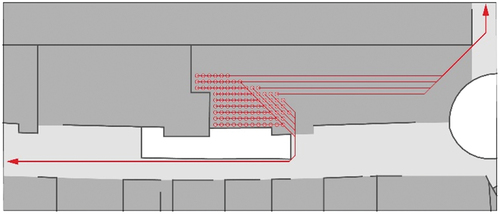
(2) Factors affecting evacuation cost in type B
The largest deviation in the evacuation cost for type B was observed in the stores on the first basement floor facing noncyclic opening. These stores have exit① and exit② with a noncyclic opening in the middle, and the nodes of the store were planned to appropriately evacuate using two exits. Regardless of the opening ratio from 17.5% to 22.5%, the exit② disappeared if the bridge was constructed at the middle of the opening, as depicted in . Thus, all nodes used the exit①, and consequently, an entirely unique evacuation route was derived or the means of vertical circulation was revised, thereby causing an overall increase in the number of nodes with a significant deviation in the evacuation cost compared to the reference case.
Figure 9. Deviation in evacuation costs according to type B characteristics: Variations in the presence or absence of entrances because of broader acyclic opening.
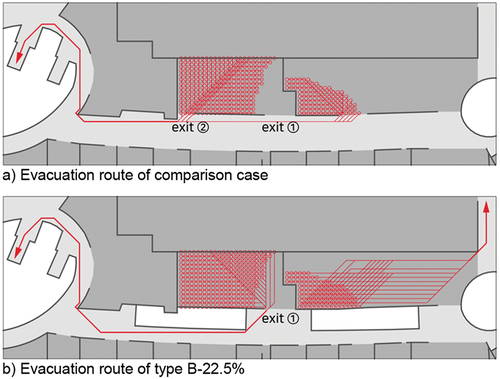
Note that if the opening is planned noncyclic, e.g., type B, it may be extremely vulnerable to evacuate from a specific space. Therefore, in case of planning noncyclic openings, the number and location of exits should be planned considering the store size, including the detour distance between the exits and the major means of vertical circulation. after which the noncyclic openings can be placed without infringing on them.
(3) Factors influencing evacuation costs in type C
As there was no node with an evacuation cost deviation of more than 10,000 compared to the reference case in type C, the nodes with an evacuation cost deviation of more than 5000 were primarily examined to observe into the detailed alteration in the evacuation route.
First, as observed in , the nodes located on the second basement level used the same vertical means of circulation with the nodes in the reference case. However, the evacuation cost slightly increased because of the increased area of the floor opening adjacent to the north atrium on the first basement level. In contrast, if the node was located on the third basement level, owing to the increased area of the floor openings adjacent to the southwest atrium at the second basement level, the vertical means of circulation modified, which consequently increased the evacuation cost.
Figure 10. Deviation in evacuation costs caused by architectural planning in type C: slight detours around floor opening on upper floor.
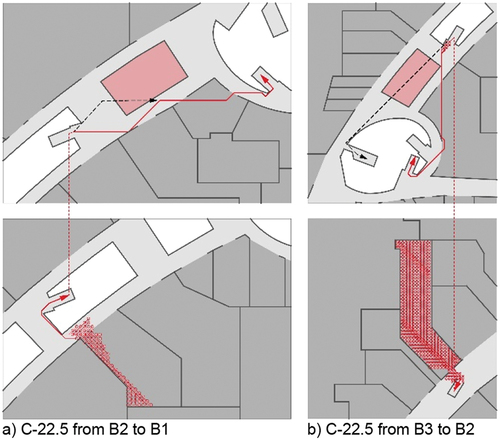
Among the nodes with evacuation cost deviation, we observed the nodes adjacent to the southeast atrium on the first basement level in type C, most of the nodes detoured slightly owing to the modification in the area of the floor opening placed in front of the store exit, which slightly increased the evacuation cost. However, no major changes were observed, unlike other types().
Figure 11. Deviations in evacuation costs caused by architectural planning in type C: alterations in vertical means of circulation.
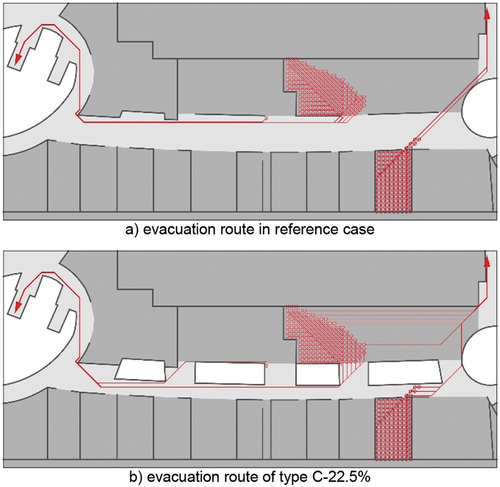
(4) Factors affecting evacuation costs in type D
Type D is characterized by the merging of the floor opening to an atrium that houses the main vertical means of circulation. Thus, unlike the reference case, as the area of the floor opening increased, the corridors connecting the exits of stores and the main vertical means of circulation were formed proximate to the opening. Therefore, even for nodes with similar evacuation costs in the reference case, the evacuation cost significantly diverged according to the planar relationship between the floor opening, the store exit, and the vertical means of circulation. In particular, the nodes with an evacuation cost deviation of 10,000 or more from the reference case were located near all the atria on the first basement level and the north atrium on the second basement level.
As a representative example of type D, the deviations in the evacuation costs at the southwest atrium are plotted in . As observed in , the existing optimal evacuation route is the route involving the escalator adjacent to the store rather than the distant stairs. However, for a floor opening area ratio of 17.5%, the floor opening was located up to the exits of store① and store② near the southwest atrium, which increased the evacuation cost of the nodes located in those stores.
Accordingly, only certain nodes of store② used the existing vertical means of circulation similar to the reference case. For the all nodes located in the store① and certain nodes in the store②, the evacuation route involving the stairs located on the same side with those nodes was derived as an optimal evacuation route. A similar increasing pattern of the evacuation cost was observed for floor opening ratios ranging within 18.5% and 20.5% owing to the planar relationship between the floor openings on the route, store exits, and the vertical means of circulation. However, for the floor opening area from 21.5% to 22.5%, the evacuation cost using the north atrium was much less than that of employing the existing vertical means of circulation bypassing the floor opening created on the route. Accordingly, the derived route was completely distinct from the reference case.
In contrast, for a floor opening area of 17.5%, the floor opening in store③ was extended to the exit of stores such as store① and store②. However, the evacuation cost did not increase for the nodes located in that store. Moreover, the evacuation cost of nodes in the stores located on the same side with store③ exhibited an evacuation cost deviation of less than 10,000 from the reference case, regardless of the increased floor opening area.
The case in which the noncyclic atrium and the floor opening impacted the evacuation route in type D was examined based on the observations depicted in . In case of nodes with evacuation cost deviation of 10,000 or more in store①, an optimal evacuation route involving an adjacent exit to the store was derived based on the reference case, as it included no floor openings. Moreover, for the ratio of floor openings from 17.5% to 19.5%, there was no deviation in the evacuation cost, because the floor opening did not obstruct the corresponding exit. However, as the exit to the store used was hindered by the floor opening in case the floor opening area increased to 20.5%, the alternative exits in the store were used for evacuation and the evacuation cost increased. For the nodes in which the evacuation cost differed by more than 10,000 at the store②, the optimal evacuation route involving the same vertical means of circulation was derived in all the nodes in the store, because no floor openings existed in the reference case. Nonetheless, as the floor openings were created and increased from 17.5% to 22.5%, several nodes in the store bypassed them.
Figure 13. Modifications in evacuation routes because of relationship between entrances to stores and floor openings.

After examining the factors for revising the evacuation cost in type D through variations in the evacuation routes, certain stores located between an atrium or a floor opening and the main vertical means of circulation were particularly vulnerable to evacuation in case of type D. Moreover, for planning the atrium or floor openings such as Type D, an appropriate number of bridges may be considered to avoid exceedingly long floor openings arranged in series, or including another vertical means of circulation on the opposite side to reduce the vulnerability of evacuation in Type D.
5. Discussion
The analysis results revealed four major conclusions. First, regardless of the type of floor opening and atrium in the multipurpose commercial building, planning a smaller floor opening is more advantageous for evacuation. Overall, the most advantageous case for the evacuation comprised only the atrium and floor opening required for vertical movement.
Second, such as in type C, if the floor opening is appropriately divided and a bridge connecting the circulation is constructed in the middle, it could be advantageous for evacuation. Upon considering only the average evacuation cost, the evacuation cost in the descending order pertained to types D, C, B, and A, whereas in case of type C, the variations in the evacuation cost from the comparison case is mostly less than 5,000. In types B and A, only a small number of nodes exhibited evacuation cost deviations of 5,000 or less from the reference case. However, the number of nodes with evacuation cost deviations of 10,000 or more was significantly higher than that in type C. This signifies that less proportion of nodes in bridges in type C were affected by the evacuation efficiency from the floor opening and atria.
Third, a more advantageous evacuation plan considers the floor opening and atrium in a cyclic manner than planning a noncyclic profile. In particular, this deviation became more significant as the area of the floor opening increased. The increase in the area of the floor opening influenced the exit to the store and drastically increased the evacuation costs at certain nodes in that store. Moreover, the creation of bridges and exits to the store with insufficient sizes, resulting from the increased area of noncyclic floor openings, e.g., type B, hinders the evacuation to a greater extent than the gradual increase of the noncyclic floor openings from the center of the corridor, such as in type A.
Fourth, when the floor opening and atrium are merged, e.g., in type D, to induce bypassing of the floor opening and utilize the main vertical means of circulation, the floor opening should not be excessively long. Thus, the installation of a bridge at an appropriate location, considering the relationship of the exit to the stores and vertical means of circulation, e.g., in type C, should aim to avoid any evacuation vulnerabilities, while promoting a positive effect of the floor opening and atrium.
6. Conclusions
This study analyzed the effect of floor openings and atria, which constitute the elements of architectural planning for multipurpose commercial buildings on evacuation efficiency of the buildings. To this end, the evacuation costs were derived according to the type and area of the floor opening and atria in the plan. In addition, the effect was analyzed by comparing the evacuation routes among various cases. As a result, the study revealed the impact of the size and the type of the floor openings and atria on evacuation. This paper clarified the impact of the floor openings and atria on evacuation in perspective of scientific and objective analysis method. Although prior research focused on analyzing the impact of floor openings and atria on the evacuation efficiency in buildings from the perspective of engineering and facility, this study followed a quantitative methodology to analyze the effects of the floor openings and atria for the architectural planning aspects.
The contribution of this paper is not only disclosing the impact of the floor openings and atria on the evacuation but also the methodological improvement in the ECEM. In the ECEM proposed by Choi, Kim, and Choi (Citation2006), it was possible to move at once regardless of distance if it can be visually connected, but in the Cellular ECEM method developed in this study, more detailed analysis is possible because the evacuation cost is analyzed based on 1,000 mm✕1,000 mm grid. In addition, unlike previous studies, weights can be applied to links expressed the vertical means of circulation differently to suit the situation, whether they are stairs, escalators, going up or down, which can reflect more realistic situations.
The limitations of this study include its subject limited to the IFC Mall in Yeouido.
Nonetheless, the research method and research tool of this paper have the versatility of analyzing evacuation costs by applying to a cad file of any buildings consisting of simple lines expressed the obstacles such as walls and the floor openings as a series of lines and the vertical means of circulation as a link between floors.
In addition, before considering complicated building facilities, structural facilities, etc., evacuation costs can be analyzed only by physical connections between spaces in the design stage, thereby increasing the efficiency of the design process. Se there are many cases where the Multi-use Commercial Buildings contain the floor openings of various shapes and sizes, if the research method of this paper is applied to various cases, it will be possible to analyze the relationship between the shape, size of the floor openings and evacuation cost of the building more closely. Therefore, the findings of this study should be verified with follow-up studies on various multipurpose commercial buildings.
In addition, subsequent studies are required to cross-validate the current study results through empirical experiments using a evacuation simulation software such as Simulex and FDS. Thus, the relationship between the architectural planning elements and evacuation efficiency should be explored further.
Disclosure statement
No potential conflict of interest was reported by the author(s).
Additional information
Funding
Notes
1 A large-volume space created by a floor opening or series of floor openings connecting two or more stories, which is covered at the top of the series of openings and used for purposes other than an enclosed stairway, an elevator hoistway, an escalator opening, or as a utility shaft used for plumbing, electrical, air-conditioning, or communications facilities (NFPA 1852, 2019).
2 This study analyzed walking speeds on stairs according to the riser height to evaluate total evacuation period following the research of Fruin (Citation1971), and Pauls (Citation1980), who experimentally determined the correlation between walking speeds and pedestrian density.
3 Number of nodes on vertical axis presented in logarithm scale to prominently indicate the variations, and evacuation cost is denoted on the horizontal axis is expressed as a number representing the range divided by 1000.
References
- Choi, J., and W. Hong. 2013. “A Suggestion on A New Correction Coefficient for SIMULEX Egress Model to Predict Agent’s Stair Slope Travel Time in A High-rise Building.” Journal of the Architectural Institute of Korea—Planning and Design 29 (3): 285–292.
- Choi, J., M. Kim, and H. Choi. 2006. “Development of Evacuation Cost Analysis Method Based on Euclidean Distance with Visual Depth.” Journal of the Architectural Institute of Korea 22 (12): 115–122.
- Edgett, S., and A. M. Williams. 1958. “Vertical Circulation.” In Building Design and Construction Handbook, edited by F. Merritt and J. Ricketts, 16.1–16.47. 6th ed. New York, NY: McGraw Hill Professional.
- Fruin, J. 1971. Pedestrian Planning Design, Metropolitan Association of Urban Designers and Environmental Planners. New York: Inc.
- Hung, W. 2003. “Architectural Aspects of Atrium.” International Journal on Engineering Performance-Based Fire Codes 5 (4): 131–137.
- Hung, W., and W. Chow. 2011. “A Review on Architectural Aspects of Atrium Buildings.” Architectural Science Review 44 (3): 285–295. doi:10.1080/00038628.2001.9697484.
- Kim, M., Y. Kim, J. Cha, G. Han, and J. Park. 2020. ”A Comparative Analysis of the Relationships between the Evacuation Routes and the Size of Void Areas on Architectural Plans.” Proceedings of the 2020 Autumn Annual Conference of AIK, 40(2), 169–172.
- Kusumowidagdoa, A., A. Sacharib, and P. Widodob. 2015. “Visitors’ Perceptions on the Important Factors of Atrium Design in Shopping Centers: A Study of Gandaria City Mall and Ciputra World in Indonesia.” Frontiers of Architectural Research 5 (1): 52–62. doi:10.1016/j.foar.2015.11.003.
- Lee, K. 1994. “A Study on the Fire Safety of Atrium Buildings.” Journal of the Architectural Institute of Korea 10 (8): 67–79.
- Lei, W., Z. Zheng, C. Rong, G. Tai, G. Zhao, and A. Li. 2022. “Study on Fire Smoke Control in Evacuation Passageways on the Top Floor of an Atrium Involving Breathing Zones Combined with Underfloor Makeup Air Supplementation.” Safety Science 153: 105807. doi:10.1016/j.ssci.2022.105807.
- Moosavi, L., N. Mahyuddin, N. A. Ghafar, and M. Ismail. 2014. “Thermal Performance of Atria: An Overview of Natural Ventilation Effective Designs.” Renewable and Sustainable Energy Reviews 34: 654–670. doi:10.1016/j.rser.2014.02.035.
- Nelson, H., and F. Mowrer. 2002. “Emergency Movement.” In The SFPE Handbook of Fire Protection Engineering, 3.367–3.380. 33rd ed. Qunicy: National Fire Protection Association.
- Park, C., Y. Lee, M. Kim, M. Yoon, Y. Choi, J. Park, and H. Kim. 2009. “Case Study about Performance Based Design through Fire & Egress Simulation for Atrium of A Hotel & Casino.” Journal of Korean Institute of Fire Sci. & Eng 23 (2): 13–19.
- Pauls, J. L., 1980. “Effective-Width Model for Evacuation Flow in Buildings.” Proceedings, Engineering Applications Workshop. Society of Fire Protection Engineers, Boston.
- Rafinazari, A., and G. Hadjisophocleous. 2020. “An Investigation of the Effect of make-up Air Velocity on Smoke Layer Height with Asymmetric Openings and Rotational Air Flow in Atrium Fires.” Journal of Building Engineering 27: 100933. doi:10.1016/j.jobe.2019.100933.
- Xu, X., Z. Wang, X. Liu, C. Ji, N. Yu, H. Zhu, L. Li, and P. Wang. 2017 Study on Fire Smoke Control in Super-high Building Atrium . “Study on Fire Smoke Control in Super-high Building Atrium.” 2017 8th International Conterence on Fire Science and Fire Protection Engineering. Shanghai, China https://doi.org/10.1016/j.proeng.2017.12.083
- Xu, L., Y. Wang, and L. Song. 2021. “Numerical Research on the Smoke Spread Process of thin-tall Atrium Space under Various Ceiling Height.” Case Studies in Thermal Engineering 25: 100996. doi:10.1016/j.csite.2021.100996.

